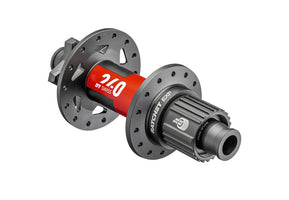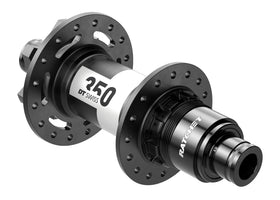I grew up thinking bikes were engineering magic. I’d often take components apart, and much to the chagrin of my parents, be unable to put them back together. In particular, the clicking that bikes make while freewheeling always drew my interest, but I could never figure out how to get inside the hub to find out where this noise was coming from. When I started working at a shop as a young teen, I finally had the tools I needed to dive into the inner workings of bike hubs. Of all the different designs out there, the DT Swiss 350 blew me away with its genius simplicity.
 DT Swiss's new 350 MTB hub, on top, with the long-standing previous generation on bottom.
DT Swiss's new 350 MTB hub, on top, with the long-standing previous generation on bottom.
If you’ve seen our videos on the Industry Nine Hydra hub and Onyx’s hubs, you know how wildly cool those designs are, and the incredible advantages that precisely machined pawls and sprag clutches can bring.
The specs of DT 350, on the other hand, have never been much to write home about, nor do its looks or sounds conjure images of the gorgeous custom builds Fanatik is known for. Even so, this is a piece that has stood the test of time as one of mountain biking’s most easy-to-own hub designs, and has now been further refined into a component worthy of the dreamiest build you could put together.
Today, we’ll take a look at the Ratchet mechanism that makes the 350 such an amazing hub, as well as the newer Ratchet EXP design that the ultra-lightweight 240 hub runs, and we’ll examine what changed between the new and old versions of these hubs.
 The stunningly simple DT Swiss Ratchet system. Two large springs sit on the outside of the toothed rings.
The stunningly simple DT Swiss Ratchet system. Two large springs sit on the outside of the toothed rings.
Simply Genius - DT’s Ratchet Mechanism
The ratchet design common to DT hubs, the thing that makes them so special, can be seen in the photo above... It’s simply two metal rings with splines on the outside and ramped teeth on the inside, which are pushed together by a large spring on each side. That’s it. The outer splines keep the rings from spinning in their housing, while allowing them to move towards and away from each other, and the ramped teeth push the rings apart in one direction while locking in the other.
It’s a design that doesn’t have any tiny parts to lose or break, isn’t affected by a little dirt and grime, and has withstood the test of time. In fact, the original US patent for this design was filed in 1995, 26 years ago, and has been licensed to massive OEM brands like Roval from Specialized and Bontrager from Trek.
People are quick to point out that this design has a maximum of 54 points of engagement, and that’s only if you upgrade it with a new set of rings. The 2021 DT 350 comes stock with 36t ratchets, while the previous gen had 18t. That is obviously not as much as the Industry Nine Hydra’s 690 points or Onyx’s instantaneous engagement. High engagement is cherished by people who love techy, challenging climbs, and is generally seen as a hallmark of performance.
 DT Swiss upgraded 54t rings on top, and their base-level 18t rings on bottom.
DT Swiss upgraded 54t rings on top, and their base-level 18t rings on bottom.
Might it actually detract from a downhiller’s riding experience though? That is the argument that DT Swiss makes, and there is absolutely logic to it. Here’s the summarized version:
The higher the engagement of your hub, the more your forward facing pedal will kick back as you move into your rear wheel’s travel. When you push back against that kickback with your legs, as one usually does, the bike’s rear suspension is unable to move into its travel properly.
DT makes the case that by running hubs with greater than 36 points of engagement, where the hub engages once every 10 degrees of rotation, we are creating a situation where we detract from the functionality of our suspension.
In a world where most of us are riding for the downhills, that’s a pretty compelling argument. If you want to see the math and physics behind it all, check out DT's rundown here.
Does this mean that you should go and trash your current, high engagement wheel? Not at all. In my experience, I’ve always found that I get used to what I’m riding very quickly, whether it’s an 18t engagement 350, or an infinite engagement Onyx hub.
However, if you’re considering a new wheelset and going downhill fast is what you like, I would totally recommend the new 350 or 240. Let’s take a look at them.
New VS Old - DT 350
Externally, the new 350 is vastly different then the previous version. The cosmetic differences are immediately obvious; the new version is a lovely matte black that uses waterslide decals, whereas the old ones were vinyl. That does mean that you can’t remove the new ones, but they look so good I don’t think you’ll want to.
 The old DT 350 (top) and the new (bottom).
The old DT 350 (top) and the new (bottom).
Moving in from the ends, you’ll notice that DT has machined a lip into the hub’s end-caps, which make them substantially easier to remove by hand - a welcome change. It’s worth noting that this new endcap design will also work on older 350 and 240s hubs, so if you ever were to loose an endcap, this would be an easy upgrade!
The hubshell itself sports substantial refinement, and that’s where see the bulk of the 14g weight difference. The brake rotor tabs are much more cut out, as is the non-drive side hub flange. The center of the hubshell has a noticeably larger diameter, although the axle housed inside is the same as the previous model, as are the 6902 bearings used inside.
The most functionally different part of all this is the stock ratchet set supplied with the hub. The new model comes with the super light 36 tooth set, which is hollowed out, versus the heavier and lower engagement 18t set that used to come stock with the 350.
Impressively, DT is offering the new 350 for only $40 more than the old version, all while dropping 14 grams, doubling the hub’s engagement while still offering phenomenal suspension performance, and giving you a substantially nicer looking hub.
New 350: 279g - microspline, 12x148mm, 6-bolt
Old 350: 293g - microspline, 12x148mm, 6-bolt
New VS Old - DT 240
The 240 has always been a substantially lighter hub than the 350, and at 237 grams with a microspline driver, that is still the case. If weight is a major consideration for you, you’ll still want to opt for the 240 to save those 42 grams. Historically, that has been the only functional difference between this model and the 350 though.
 Internal differences between the new Ratchet EXP (top) and the normal Ratchet design (bottom).
Internal differences between the new Ratchet EXP (top) and the normal Ratchet design (bottom).
With the new 240, DT uses their new EXP ratchet design. Remember how the normal ratchet features two free floating rings that are pushed against each other? With EXP, one of these toothed interfaces is fixed to the hub shell, with only the driver side getting a free-floating ring and spring. This not only means fewer, lighter parts, but an even more solid feeling connection during engagement.
Because the inner ratchet is a stationary, hollowed out piece on the EXP system, DT is also able to install the axle bearing directly inside it, increasing the distance between the bearings on each side. That results in a hub that better distributes the forces it is subjected to, and, all else equal, will have longer bearing life.
 DT Swiss's new EXP Ratchet, on display. Note how the axle bearing can now sit inside the inner ratchet, allowing it to provide better bracing.
DT Swiss's new EXP Ratchet, on display. Note how the axle bearing can now sit inside the inner ratchet, allowing it to provide better bracing.
It bears noting that some earlier EXP hubs had engagement issues, wherein the ratchet would sometimes bind within the freehub so you wouldn’t get any connection. DT found that to be from an issue in the surface treatment of the new ratchet, and they have since remedied the problem. If you do have one of the first EXP hubs and start to encounter that issue, DT will provide you with new internals so you can get back out on the trail.
As far as changes from the old 240 to the new, the EXP Ratchet is the biggie. Despite the similarities in the design, EXP is slightly louder than a normal ratchet mechanism, probably because the spring behind the moving ratchet exerts a bit more force. It’s not a massive difference, but it’s noticeable.
 DT's new EXP Ratchet freehub mechanism.
DT's new EXP Ratchet freehub mechanism.
Lastly, there are a number of cosmetic differences, from the new matte finish and waterslide decals, to a more angular and clean appearance.
New 240: 237g - microspline, 12x148mm, 6-bolt
Old 240: 232g - microspline, 12x148mm, 6-bolt
Which one to pick?
If downhill speed and suspension performance is important to you, you’re already winning by selecting either of these hubs for your upcoming wheel build. Not only will they improve your suspension’s action by decreasing pedal kickback, but they are both some of the lightest hubs out there. Even the 350 weighs less than the lightweight Hydra classic, which at 295 grams comes in 16 grams heavier. Because your rear wheel is un-sprung, extra weight there makes a significant difference in how quickly your rear swing-arm can change direction.
On that note, the 240 is going to be the best way to go. But, it’s also over $200 more expensive. If budget is a consideration for you, then the new 350, which costs less than $300, is unbeatable. As we saw, it’s also a little bit quieter than the new 240, so if you want an ultra quiet hub, the 350 is the best option.
 The new DT 350 and 240 mountain bike hubs, side by side.
The new DT 350 and 240 mountain bike hubs, side by side.
I really hope you’ve enjoyed learning about DT’s amazing hubs as much as I’ve enjoyed explaining them to you. If you'd like to get your own custom wheelset built, simply click on our Custom Wheel Builder tool below or at the top of our website.
Happy trails - Dan at Fanatik
Related Products
More Articles You Might Like
View More:




